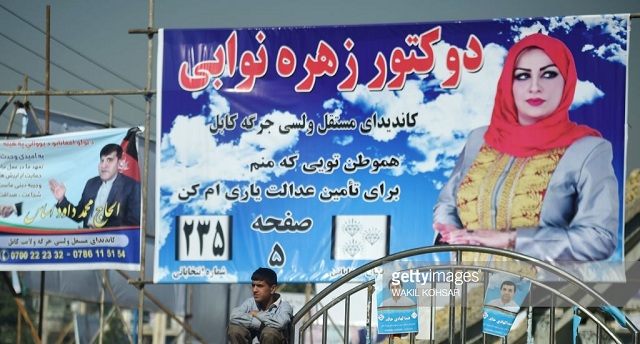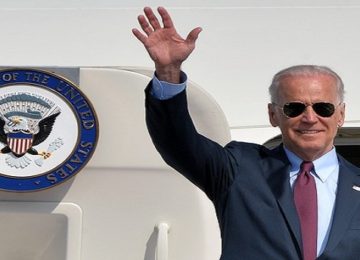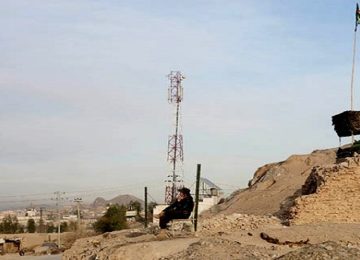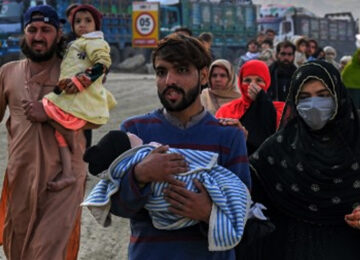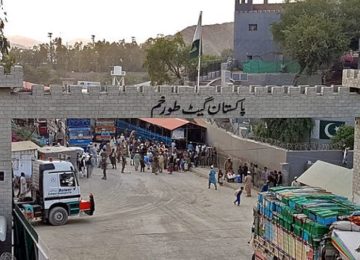October 19, 2018
On 20 October, more than 400 female candidates will compete for the 68 parliamentary seats reserved for women. Many more women – there are over three million registered female voters – will cast their votes on Saturday, in an attempt to have their say on who represents them in the lower house of the parliament. AAN’s Jelena Bjelica and Rohullah Sorush have been looking back at women’s political participation in earlier decades and hearing from female candidates in Afghanistan about running for office despite threats, campaigning (in some places) despite having to wear a burqa, and being told by men that it is a sin to vote for a woman.
Afghan women, according to a 2014 UNDP report, have a higher political participation at the national and subnational level of governance than women do in Pakistan, Bangladesh and Nepal. The reason for this is Afghanistan’s constitutional quota system, which reserves 68 out of 250 seats in parliament (27 per cent) for women (see this AAN’s guide to the Afghan parliament). (See Annex 1) Yet despite this high ’gender score’, any Afghan woman actually wanting to get into parliament needs courage – or money or, according to one report, ‘warlord backing’.
The quota system means there will always be at least 68 women in parliament. In 2018, as in 2010, the number of women candidates is roughly the same – about 400 women out of a total of about 2,500 candidates. (See Annex 1 for detail about the women running and AAN’s basic facts about the 2018 elections here.) In 2010, official women turnout was significant, comprising about 39 per cent of the total (1,668,617 out of a total of 4,265,354 votes cast according to the Independent Election Commission [IEC]). There needs to be some caution about this figure, though, as particularly in southern provinces there was ‘bulk voting’, ie men casting votes ‘for their women’ without them being present at the polling centres (AAN reporting here).
In Nimruz province, there was a particularly high female turnout – 60 per cent of the votes were cast in female polling stations. The two main female candidates there were locked in such a fierce competition that they won both parliamentary seats allotted to Nimruz (see this AAN analysis here), both the reserved women’s seat and the ‘open competition’ seat. This is turn meant that women secured 69 seats in the 2010-elected Wolesi Jirga.
This year has seen a slightly lower proportion of women registering to vote. In 2004 and 2010, the proportion of registered voters, male to female, was roughly 40:60. This year, it is 36:64 (3,067,918 women in total). (See this AAN analysis).
Although the numbers look good on paper, they belie the difficulties many Afghan women face, both those pursuing a political career and those exercising their right to vote, given Afghanistan’s traditional patriarchal society.
Favouring men
The most evident challenge that women candidates face is that they are women in a male-dominated and largely sex-segregated society, one that, in many areas, castigates women for taking public roles. The fact that a lot of politicking is done in all-male gatherings just adds a further obstacle. As the renowned historian, the late Nancy Dupree, wrote in her 1981 paper “Revolutionary Rhetoric and Afghan Women”, being an MP also hardly fits the dominant model of idealised Afghan womanhood:
Afghan history and folklore is replete with idealized accounts and legends of heroic mothers and wives who provided inspiration to their menfolk in times of crisis. If the ideal personality type for Afghan men is the warrior-poet, a lauded personality type for Afghan women is the poet-heroine.
In other words, the model Afghan woman inspires and supports her menfolk, rather than acting in her own right. Dupree, in the same paper, looks at how the first handful of women went against the grain by standing for the 1965 parliament (women were given the vote in the 1964 constitution). This was in the pre-quota era when all candidates, men and women, ran in open competition with each other (as was the case globally). It is only in more recent years that some parliaments and some political parties have established quotas for women. Four women, said Dupree “stood for, and won election to the Wolesi Jirga (Lower House) of the 12th Parliament.”
During the 1969 parliamentary elections, women failed to secure any seats (see Hafizullah Emadi’s paper, “Establishment of Afghanistan’s Parliament and the Role of Women Parliamentarians: Retrospect and Prospects”, 2015). Emadi points out that between the 1973 coup that brought down the monarchy and constitutional changes in 1987, noparliamentary elections were held. Nevertheless, four women participated in Prime Minister Daud’s Melli Jirga (National Jirga), a hand-picked parliament that was convened in 1977. During much of the pro-Soviet PDPA rule, the Revolutionary Council ruled the country had a number of female members.
After Najibullah introduced a new constitution in July 1987 that revived the parliamentary system, there were a number of women MPs from Kabul and the provinces. “Parliamentary elections under the Soviet occupation were supervised by the pro-Soviet ruling party and individuals with close ties to the party secured seats in both houses of parliament,” Emadi concludes. The 1988 election was mainly based on seats allocated in advance, with some given to non-party members, newly registered (leftist only) opposition parties and some seats kept for the mujahedin, and with only symbolic voting. All in all it was designed to safeguard a majority for Najibullah’s Watan party (the renamed People’s Democratic Party of Afghanistan).
On the ‘other side’ of the war, in the exiled communities of Pakistan where millions of Afghan refugees lived, as Dupree noted in a 1989 paper “Seclusion or service: Will women have a role in the future of Afghanistan?” which also deals with women’s political participation, women’s lives there were deliberately limited. Dupree noted that the ‘interim government’ formed by the seven major Sunni mujahedin factions severely restricted the lives of Afghan women in refugee camps in Peshawar, on ideological grounds, to family duties and roles of mother and wife. The Supreme Council of the seven parties, she wrote, directed the interim government, to “Develop moral virtues and combat corruption and denigration by observing the principles of purdah…”(1) Dupree also noted that the political charters issued by the seven factions, in addressing women-related issues, ranged from “explicit insistence on strict seclusion to generalized statements supporting women’s participation in the task of development.” (see page 3 to 5 of the paper). She added:
At the two-week Shura (Consultative Council) meetings held in Islamabad in Feb.-Mar. 1989 to elect yet another interim government, a proposal to include women was flatly rejected (personal communication).
Since 2001, Afghan women have not only had the right to vote and stand, but the quota system reserves them seats. Even so, the social stereotypes referred to by Dupree in 1981 have survived, as have the obstacles women encounter if they attempt to go ‘against the grain’ and run for parliament, as AAN found out when hearing from some of the female candidates.
Going against the grain
Mariam Durrani,one of 13 female candidates from Kandahar province for the 2018 Wolesi Jirga elections told AAN that the people in her province are actively advocating againstwomen candidates:
I heard from a friend that a taxi driver was telling passengers not to vote for women. He said it was illegal [to vote for women]. We openly see that men have more [public] support than women.
Mina Jalal, one of the three female candidates from Kunar province, shared a similar story:
The day before yesterday I went to campaign in an area. A woman told me that she and other women were told not to take part in election, but if they did, they should not cast their votes for female candidates because it was a sin.
Jalal praised the woman for her wittiness. “If voting is a sin,” she had told those trying to lay down the law, “it’s a sin for both men and women.”
IWPR also reported that Shahba Shahrokhi, one of the six female candidates running for one seat reserved in Samangan province was facing difficulties within her own family:
When I decided to nominate myself, my family immediately disapproved of my decision, with my close relatives then following suit by expressing negative ideas that, as a girl, I would be unable to succeed… [They told me] that there were too many problems, that this society and its traditions have always been against women who somehow make trouble for men. All these words and excuses were intended to change my mind, but I refused to accept this.
In Helmand province, where out of 92 candidates nine women are running for two reserved seats, one of the female candidates, Jamila Niazi, complained to Pajhwok that she was unable to conduct her election campaign, “We face public criticism – culturally motivated – if we display our photographs as part of the campaign.”
Some other candidates, like Shekiba Hashemi, sitting MP and candidate from Kandahar province have not been allowed to campaign in public places. Hashemi told AAN she was not allowed to campaign in the central Shia mosque in Kandahar, the Imam Bara mosque, because she is a woman. “They only allowed one candidate, Sayed Moqtada Miran, to campaign in the mosque, but not the others, specifically not me, a woman,” she said.
Yet ‘sisterly’ support is also not forthcoming, said some of the women candidates we spoke to, with fierce rivalry among women running for office. Shirin Mohseni, a female candidate from Daikundi said that, although she is in her view a leading candidate in Daikundi, “there is a strong and negative rivalry” among women contenders in her province. She told AAN:
There is a rumour that my name has been removed from the list of Daikundi candidates. I know it is the women who are saying this.
Samira Khairkhwa, a female candidate from Balkh also said her problem come from the competition. “Some rival candidates whose names I can’t say have torn down my photos in some areas,” she told AAN.
Security issues
Insecurity during the election campaign is, however, probably an even bigger problem facing women candidates. Humaira Ayubi, a former MP from Farah province and one of the three female candidates running there this year, described the problems:
I have not been able to get out of home and go for campaigning. I am running my campaign from home and people come and visit me here, but I was hoping to go to the villages and see the people. Now, when someone does not have a good appearance and comes to my home, I am really scared he might be an attacker. Insecurity is very high in Farah.
She said that in many villages in Farah province, elections will probably not take place, like in the village of Genahkan, where the fighting is so intensive that all its residents have left the area. This according to Aybi means 900-950 fewer voters. She said that in Kahdanak village, the Taleban have threatened people not to participate in the election.
In Kahdanak, there is propaganda against another female candidate, Belqis Roshan. People have been told [by the Taleban] not to vote for her because she is an infidel.
(Belqis Roshan is close to leftist-feminist former MP Malalai Joya, also from Farah, who has been expelled from the Wolesi Jirga in 2007 after she raised some vehement criticism of the warlords in its ranks.)
Mariam Zurmati, one of eight female candidates in Paktika province has similar concerns. She is reliant on meeting the people, she says, because she cannot afford to pay voters – but meeting the voters is difficult because she is a woman.
There are threats from the Taleban. It is against all Afghans and the candidates, but it impacts women more because it prevents women from having big gatherings and campaigns. Also, because the society is very traditional here and the level of awareness is very low, it is difficult for women candidates to appear in big gatherings. Some former MPs and also current candidates are spending a great deal of money to buy the people and their votes, but I can’t do this.
Mina Jalal, one of three female candidates from Kunar province also pointed to the restrictions female candidates face. She said many have to wear burqas when they go to campaign in the villages, which for a candidate campaigning in Afghanistan where his or her face is their identity, is a serious impediment. She told AAN:
I went to campaign in my own district, Narai. There were security threats from the Taleban… I went only with a driver and another person and I also wore a burqa so that nobody could know me on the way. Women candidates can’t hold big campaigns due to threats. They also must wear a burqa when they go to villages.
Many other women candidates AAN spoke to faced the same or similar security concerns, with threats coming not only from the Taleban, but also local armed groups. Gulalai Nur Safi, a former MP from Balkh province who is running again, told AAN that security concerns in her province revolve around ‘irregular armed groups’. One of her campaigners was beaten up in Salarzayi village by “powerful irregular armed men,” she told AAN. For security reasons, she did not want to name them.
In Takhar, in Rustaq district, a campaign rally for female candidate Nazefa Yusofi Beg was targeted with a bomb (see here). 22 people were killed and many others injured in the attack, although Yusofi Beg escaped unscathed. Given the marginal presence of the Taleban in the district and the history of irregular armed groups there, suspicion has largely fallen on the latter (see this AAN report about insurgent groups in Takhar). (There is more information about female candidates in this AAN overview).
Women – once they get into parliament
Justbecause Afghan women can stand and vote and have a secured presence in parliament does not mean, however, that women MPs will necessarily work for women’s rights. A study by Oxfam in 2011 on safeguarding women’s rights found that Afghan female MPs lack of unity holds them back. Women MPs have not capitalized on their chunk of seats and their potential influence in parliament to try to improve women’s lives. The Oxfam study pointed not only to disunity, but also who was backing at least some of them and who they might actually be answering to.
Female parliamentarians are disunited; many are elected with the support of warlords and are answerable to them. One result of this is that female politicians do not necessarily work to support women’s rights. For example, the 2009 Shia Personal Status Law was passed by a parliament with over 25 per cent female representation despite the fact that it drastically restricts the rights of Shia women and violates the constitution.
Another case in point is the 2013 parliamentary discussion on the Elimination of Violence Against Women (EVAW) law, when MP Fawzia Kufi insisted the law be debated, a move which almost cast it into oblivion (for more detail on this, see AAN reporting here and here).
If running for parliament in Afghanistan as a woman is a job for a heroine – facing down security threats and fighting stereotypes – the record of women MPs once in power has been something less than heroic. Afghanistan’s high ‘gender score’ based on the parliamentary quota system belies a less attractive reality.
Edited by Kate Clark
(1) The Islamic Unity of Afghan Mujahideen (IUAM) interim government included: Gulbuddin Hekmatyar’s Hezb-e Islami; Hezb-e Islami-ye Afghanistan headed by Mawlawi Muhammed Yunos Khales; Mahaz-e Melli-ye Islami-ye Afghanistan led by Sayyed Ahmad Gailani; Rabbani’s Jamiat-e Islami; Harakat-e Enqelab-e Islami-ye Afghanistan led by Mawlawi Muhammadi; Mujadidi’s Jabha-ye Nejat-e Melli-ye Afghanistan; and Sayyaf’s Ittehad-e Islami-ye Afghanistan.
Dupree writes in a 1989 paper “Seclusion or service: Will women have a role in the future of Afghanistan?” on page 6:
An official published pronouncement which disturbed many men as well as women was issued in March 1988 when the Supreme Council of the 7-party Islamic Unity of Afghan Mujahiden (IUAM) sponsored the formation of an interim government. On 4/24/88, they published a set of guidelines (Itehad-e-Islami; Afghan Jehad 1(4):2). This document consists of four chapters with 87 articles. Only one specifically mentions women. Article LVII, in Chapter III, outlining the Powers and Duties of Government, directs the government to:
Develop moral virtues and combat corruption and denigration by observing the principles of purdah (seclusion) provided for in the Sharia, ensure the unalienable rights of all individuals, men and women alike, and provide dignified conditions in the light of Islamic teachings.
Although the effectiveness of the interim government is widely questioned, this document seems to reflect a disturbing collective thinking among the Peshawar leadership and projects a dim future for women. One article cannot adequately address the problems facing women and certainly the insinuation that corruption and denigration must necessarily rise from women’s public presence is deplorable.
Annex 1: Number of reserved seats for women in Wolesi Jirga and number of women candidates for the 2018 Wolesi Jirga election (by province)
1. Kabul has 13 reserved seats, out of a total of 33 seats allocated for the province. Of the 119 female candidates for Kabul province, nine are incumbent MPs. Shahgul Rezayi who represented Ghazni province in the 2010-elected Wolesi Jirga, withdrawn her candidacy for this year’s election. Two female candidates, Sayyeda Masuda Yari and Mariam Sediqa Sadat, are former members of Kabul provincial Council. Two other female candidates for Kabul are members of political parties. Nabila Sayedjan Zada Hamid affiliated to Hezb-e Ensaf-e Islami-ye Melli and Anisa Maqsudi is affiliated to Hezb-e Wahdat-e Islami.
2. Bamyan has one reserved seat out of a total of four seats allocated for the province. Of 11 female candidates competing for Bamiyan procince, one is an incumbent MP, Safor Elkhani. One female candidate, Sharifa Arman Wasiq is affiliated to Hezb-e Ensejam-e Melli-ye Afghanistan.
3. Nuristan has one reserved seat for women, of a total two seats allocated for the province. Of seven female candidates competing in Nuristan, none are incumbent MPs and none are affiliated to any political parties.
4. Kunar has one reserved seat, out of a total of four seats allocated for the province. Of three female candidates competing in the province, one is an incumbent MP – Wajma Safi. None are politically affiliated.
5. Khost has one reserved seat, out of a total of five seats allocated for the province. One of the two female candidates competing for a seat is Sahera Sharif an incumbent MP. Neither one is politically affiliated.
6. Uruzgan has one reserved seat, out of a total of three seats allocated for the province. None of the eight female contenders is an incumbent MP. One candidate, Duranil Nurzai is affiliated to National United Movement Party of Afghanistan (De Afghanistan de Melli Wahdat Wolesi Tahrik Gund)
7. Nimroz has one reserved seat, out of a total of two seats allocated for the province. One of the three contenders, Farida Hamidi is an incumbent MP.
8. Balkh has three reserved seats for women, out of a total of 11 seats allocated for the province. Of 22 female candidates competing, three are incumbent MPs (Gulalai Nur Safi, Breshna Rabi and Saifora Niazi); and the other three are politically affiliated (Sonia Rajabi to Hezb-e Melli-ye Taraqi-ye Mardom Afghanistan (Afghan People’s National Progressive Party), Merman Robaba Nayebi, to Hezb-e Wahdat-e Mardom-e Afghanistan and Shekiba Shekib is affiliated to Jamiat-e Islami Afghanistan).
9. Daikundi has one reserved seat, out of a total of four seats allocated for the province. Of eight female candidates competing two are incumbent MPs (Shirin Mohseni and Raihana Azad). Raihana Azad represented Uruzgan province in the 2010-elected Wolesi Jirga. Shirin Mohseni is affiliated to Hezb-e Wahdat-e Mardom-e Afghanistan.
10. Herat has five reserved seats, out of a total of 17 seats allocated for the province. Of 28 female candidates competing, three candidates are incumbent MPs (Simin Barakzai, Massuda Karokhi and Nahid Ahmadi Farid). None of 28 contenders are politically affiliated.
11. Kapisa has one reserved seat, out of a total of four seats allocated for the province. Of eight female candidates competing none are incumbent MPs, nor are politically affiliated.
12. Paktika has one reserved seat, out of a total of four seats allocated for the province. Of eight female candidate,competing, Najia Babakarkhel Urgunyar is an incumbent MP. None of them have political affiliation.
13. Panjshir has one reserved seat, out of a total of two seats allocated for the province. Of two female candidates competing Rahila Salim is an incumbent MP. Neither one is politically affiliated.
14. Parwan has two reserved seats, out of a total of six seats allocated for the province. Of 11 female candidates competing, two emale candidates are incumbent MPs (Zakia Sangin and Samea Azizi Sadat). None of 11 female contenders from Parwan are politically affiliated.
15. Wardak has two reserved seats, out of a total of five seats allocated for the province. Of nine female candidates competing, two are incumbent MPs (Seddiqa Mubarez and Engineer Hamida Akbari). Two other candidates are politically affiliated. Rohina Walizada is affiliated to Hezb-e Islami and Dr Zia Gul Rezayi is affiliated to Hezb-e Wahdat-e Mardom.
16. Laghman has one reserved seat, out of a total of four seats allocated for the province. Of four female candidates competing, Zaifnun Safi is an incumbent MP. None of them have political affiliation.
17. Sar-e Pul has one reserved seat, out of a total of five seats allocated for the province. Of four female candidates competing, Aziza Jales is an incumbent MP and Marzia Ramazani is affiliated to Hezb-e Wahdat-e Mardom.
18. Badakhshan has two reserved seats, out of a total of nine seats allocated for the province. Of 9 female candidates competing, Nilofar Ibrahimi is an incumbent MP and Sadiqa Adib is affiliated to Jombesh-e Melli Islami.
19. Jawzjan has one reserved seat, out of a total of five seats in the Wolesi Jirga. Of four female candidates competing none are incumbent MPs nor politically affiliated.
20. Faryab has three reserved seats, out of a total of nine seats in the Wolesi Jirga. Of 19 female candidates competing, two are the incumbent MPs (Asifa Shadab and Rangina Kargar); and two others are affiliated to Jombesh-e Melli Islami (Gita Said and Shafiqa Sakha Yolchi).
21. Zabul has one reserved seat, out of a total of three seats in the Wolesi Jirga. Of six female candidates competing, none are incumbent MPs nor politically affiliated.
22. Samangan has one reserved seat, out of a total of four seats in the Wolesi Jirga. Of six female candidates competing, none are incumbent MPs, nor politically affiliated.
23. Kandahar has three reserved seats, out of a total of 11 seats in the Wolesi Jirga. Of 13 female candidates competing, three are incumbent MPs (Fariba Ahmadi Kakar, Shekiba Hashimi and Bibi Hamida Yosufi). Shamsia Fazli is affiliated to Hezb-e Motahid-e Melli Afghanistan.
24. Helmand has two reserved seats, out of a total of eight seats in the Wolesi Jirga. Of nine female candidates competing, Nasima Niazi and Habiba Sadat are incumbent MPs; and two other candidates, Razia Baloch and Nargis Rokhshan are former Provincial Council members of Helmand.
25. Kunduz has two reserved seats, out of a total of nine seats in the Wolesi Jirga. Of 16 female candidates competing for two are incumbent MPs (Shukria Paikan and Dr Fatema Aziz). Two other female candidates are politically affiliated. Shukria Sarbeland is affiliated to Hezb-e Islami and Frozan Golchi is affiliated to Jombesh-e Melli Islami.
26. Nangarhar has four reserved seats, out of a total of 14 seats in the Wolesi Jirga. Of 18 female candidates competing two are incumbent MPs (Sayeam Khogyani and Arian Yun). Another candidate, Shafiqa Sherzai Seyar is affiliated to Hezb-e Islami.
27. Badghis has one reserved seat, out of a total of four seats in the Wolesi Jirga. Of nine female candidates competing, only Safia Aimaq is an incumbent MP.
28. Logar has one reserved seat, out of a total of four seats in the Wolesi Jirga. Of five female candidates competing, Dr Shakila Hashimi is an incumbent MP.
29. Baghlan has two seats, out of a total of eight seats in the Wolesi Jirga. Of 12 female candidates competing, two are incumbent MPs (Najia Aimaq and Shukria Isakhel).
30. Paktia has one reserved seat, out of a total of five seats in the Wolesi Jirga. Of five female candidates competing, Razia Saadat Mangal is an incumbent MP.
31. Takhar has two reserved seats, out of a total of nine seats in the Wolesi Jirga. Of 12 female candidates competing, Habiba Danesh is an incumbent MP and Shahnaz Mariam Mahtab is affiliated to Jombesh-e Melli Islami.
32. Ghor has two reserved seats, out of a total of six seats in the Wolesi Jirga. Of 5 female candidates, Ruqia Nayel is an incumbent MP.
33. Farah has one reserved seat, out of a total of five seats in the Wolesi Jirga. Of three female candidates competing, Humaira Ayubi is an incumbent MP.
34. Kuchis have three reserved seats for women, out of a total of ten seats allocated for them. Of eight female candidates competing, Hamida Ahmadzai is an incumbent MP.
35. Ghazni has three reserved seats for women, out of a total of 11 seats in the Wolesi Jirga. However, Wolesi Jirga elections in Ghazni will not be taking place as planned on 20 October. (see AAN analysis here).
By Special Arrangement with AAN. Original link.
Disclaimer: Views expressed on this blog are not necessarily endorsed or supported by the Center for Research and Security Studies, Islamabad.



